| Columns Retired Columns & Blogs |
Ensemble Dirondo CD player Measurements
Sidebar 3: Measurements
At 3.25V, the Ensemble Dirondo's maximum output level was 4.2dB higher than the CD standard's 2V. The output was noninverting with the pushbutton polarity switch set to "0º," inverting with it set to "180º." The source impedance was very low, 1 ohm, in the bass and midrange. Though it rose to 14 ohms at 20kHz, this is still very low; the Dirondo should have no problem driving awkward preamplifier loads or passive preamplifiers. Error correction was very good. There was an occasional glitch on track 32 of the Pierre Verany test CD, which has 1.25mm gaps in the data spiral, but full once-per-revolution muting didn't occur until the 2mm data gaps in track 34.
The Ensemble's frequency response (fig.1, top pair of traces) was flat over almost all the audioband, with an inconsequential shelving-down above 10kHz. Testing with pre-emphasized data (fig.1, lower traces) revealed almost no de-emphasis error, which is most welcome, given that so many modern CD playback devices omit de-emphasis. Channel separation (not shown) was excellent in the midband, at better than 100dB in both directions. It did decrease a little at high frequencies due to the usual capacitive coupling and, more unusually, at low frequencies as well, to 79dB L–R and 87dB R–L at 10Hz, which might suggest a higher power-supply impedance than is optimal.
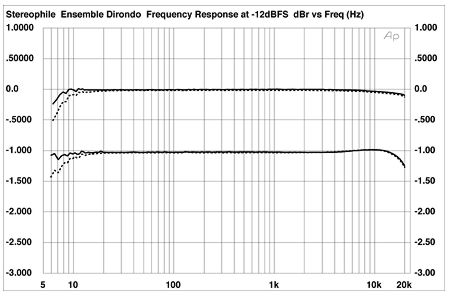
Fig.1 Ensemble Dirondo, frequency response at –12dBFS into 100k ohms, with de-emphasis (bottom) and without (top). (Right channel dashed, 0.5dB/vertical div.)
No matter how I arranged the grounding between the Dirondo and my Audio Precision test system, I couldn't eliminate faint traces of hum at 60Hz and 180Hz in the CD player's output, particularly in the left channel. This is shown graphically in fig.2, a spectral analysis of the Dirondo's output while it played data representing a dithered 1kHz tone at –90dBFS. Any 120Hz content that would result from suboptimal grounding is at or below the level of background noise; as the spuriae lie at the line frequency and its odd harmonics, their presence is presumably due to hum injected into the analog circuitry by the Dirondo's power transformer. In absolute terms, however, this hum is well below audibility.
The noise floor in fig.2 is basically due to the dither recorded on the test CD. Repeating the analysis over a wider bandwidth with data consisting of a 1LSB DC offset (fig.3) confirmed the absence of even-order power-supply components, and revealed a rising content at ultrasonic frequencies due to the noiseshaping used by the delta-sigma DAC chip.
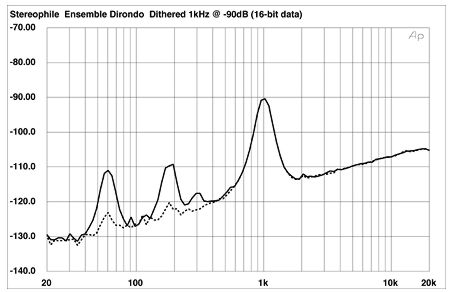
Fig.2 Ensemble Dirondo, 1/3-octave spectrum of dithered 1kHz tone at –90dBFS, with noise and spuriae, 16-bit CD data (right channel dashed).
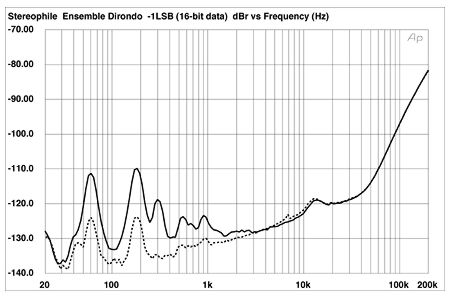
Fig.3 Ensemble Dirondo, 1/3-octave spectrum of –1LSB, with noise and spuriae, 16-bit CD data (right channel dashed).
With its relatively low noise floor, the Dirondo offered excellent linearity (fig.4). Any level error in this graph is basically that due to the recorded dither. The player's reproduction of an undithered 1kHz sinewave at exactly –90.31dBFS was excellent (fig.5), with very good symmetry, and the three discrete voltage levels described in the data clearly evident.
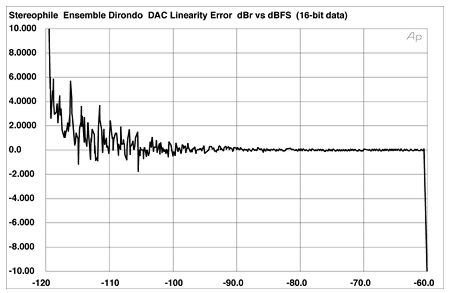
Fig.4 Ensemble Dirondo, right-channel departure from linearity, 16-bit CD data (2dB/vertical div.).
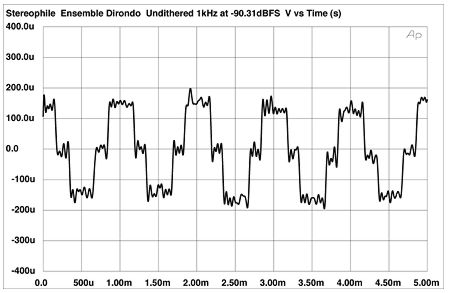
Fig.5 Ensemble Dirondo, waveform of undithered 1kHz sinewave at –90.31dBFS, 16-bit CD data.
Harmonic distortion levels were very low, with just 0.0009% (left channel) and 0.0012% (right) evident on a full-scale 1kHz tone. (Both figures are actual sums of the harmonics, without any contribution from noise.) However, spectral analysis of the player's output (fig.6) revealed some higher-order harmonics to be present as well as the usual second, third, and fourth harmonics. Yes, the fifth, seventh, and ninth harmonics are all at –100dB (0.001%) and below, but, given my druthers, I would rather have not seen them at all. Intermodulation distortion (fig.7) was also very low in level, even into difficult loads.
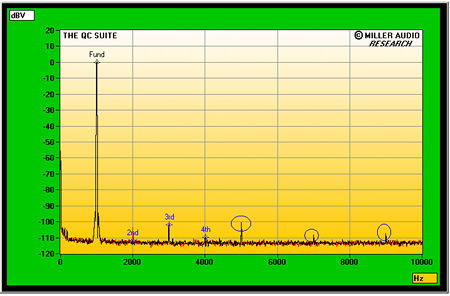
Fig.6 Ensemble Dirondo, spectrum of 1kHz sinewave, DC–1kHz, at 0dBFS into 4k ohms (linear frequency scale).
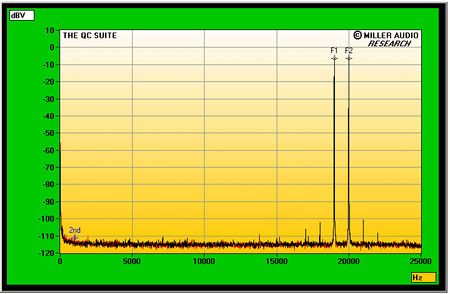
Fig.7 Ensemble Dirondo, HF intermodulation spectrum, DC–25kHz, 19+20kHz at 0dBFS into 4k ohms, CD data (linear frequency scale).
The effects of word-clock jitter, examined with the Miller Audio Research Jitter Analyzer, were very low, at an estimated 176.4 picoseconds peak–peak. However, as revealed by narrowband spectral analysis of the Dirondo's analog output while it played the analytical signal used in the test (fig.8), while data-related sidebands (red numeric markers) were almost at the residual level of the test signal, the 11.025kHz tone suffered from a spreading of its energy, due to the presence of low-frequency random jitter. (This can also be seen in the intermodulation plot as a widening of the 19kHz and 20kHz spectral lines.) Just evident in fig.8, almost obscured by the spectral spreading of the central peak, are sidebands at ±120Hz (blue "1" markers), and there are relatively strong sidebands of unknown origin at ±1.2kHz and ±1.4kHz.
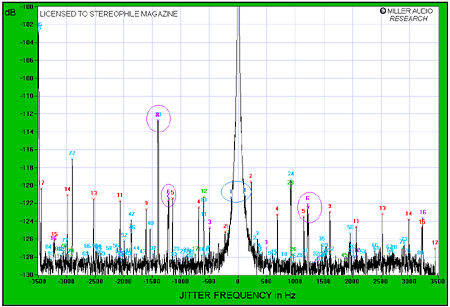
Fig.8 Ensemble Dirondo, high-resolution jitter spectrum of analog output signal (11.025kHz at –6dBFS sampled at 44.1kHz with LSB toggled at 229Hz). Center frequency of trace, 11.025kHz; frequency range, ±3.5kHz.
Predicting the subjective effect of this behavior, which presumably stems from the upsampling, is a risky business. However, I would have expected the low-frequency random jitter to produce a rather "slow" but full character. However, Brian Damkroger actually found the Dirondo's bass to be a little lightweight. Perhaps the jitter signature is outweighed by other factors.—John Atkinson
- Log in or register to post comments



































